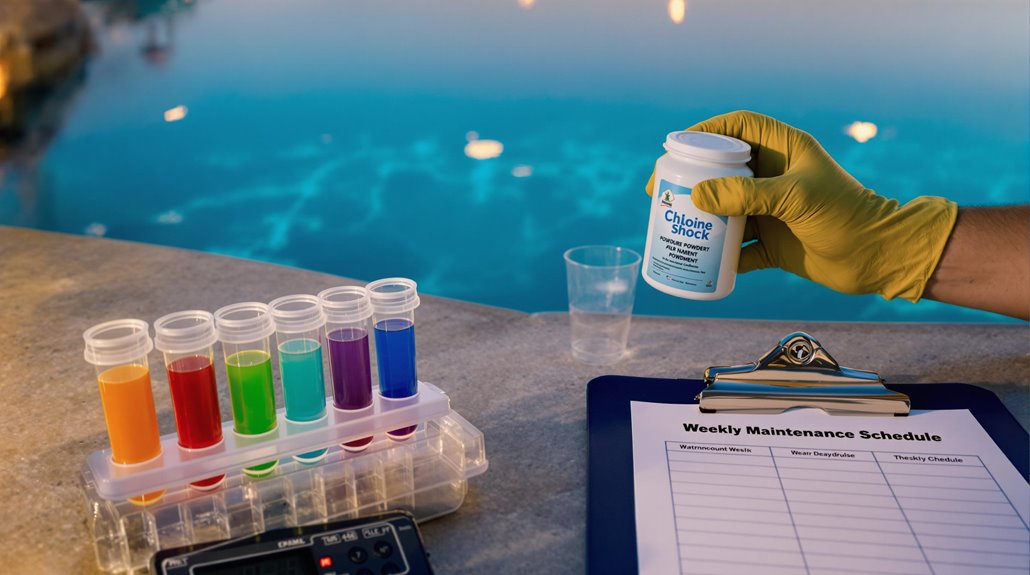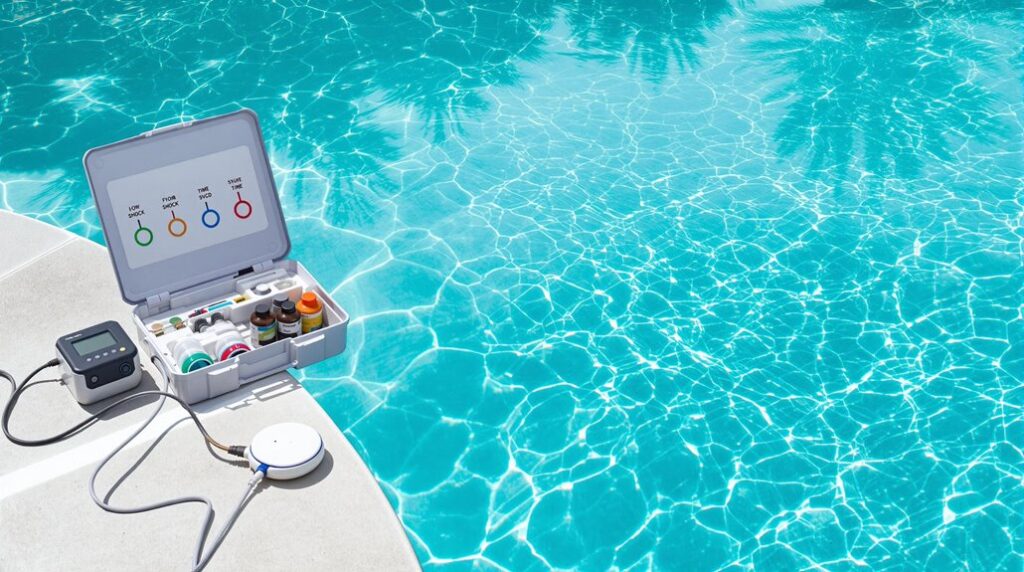You’ll need to shock your pool weekly during peak swimming season to maintain proper sanitization and prevent algae growth. For in-ground pools, use calcium hypochlorite shock, while above-ground pools benefit from gentler non-chlorine treatments. Test your water‘s pH and alkalinity before shocking, apply at night, and wait 24-48 hours before swimming. Different pool types and usage patterns may require adjustments to this basic schedule for best outcomes.
The Basics of Pool Shocking Treatment

While you’re maintaining a swimming pool, understanding pool shock treatment is essential for keeping your water clean and safe. Pool shock is a concentrated sanitizer that eliminates bacteria, algae, and chloramines, helping you restore your water’s chemical balance and maintain effective disinfection levels. Cloudy pool water often indicates it’s time for a shock treatment to restore proper sanitization and clarity. You’ll find several types of pool shock available, including calcium hypochlorite, dichlor, liquid chlorine, and non-chlorine MPS options. Each serves a specific purpose: chlorine-based shocks provide stronger sanitizing power, while non-chlorine alternatives offer gentler treatment for your pool surfaces. At the point you’re applying shock, you’ll need to dissolve granular products in water initially, add the treatment around your pool’s perimeter, and run your filtration system for 24 hours. Always wear protective gear and verify swimmers stay out of the water for at least 24-48 hours after treatment.
Recommended Shocking Schedule for Different Pool Types
Because different types of pools require distinct maintenance approaches, you’ll need to adjust your shocking schedule based on your specific pool setup. Your pool’s material, sanitizing system, and usage patterns will determine the ideal shocking frequency and products to use.
Keep your pool pristine by customizing shock treatments to match your pool’s specific type, materials, and how often it’s used.
- If you’ve got an in-ground pool, you can use stronger calcium hypochlorite shocks weekly, while above-ground pools need gentler, non-chlorine treatments to protect the liner. Performing a thorough pool inspection before starting your shock treatment ensures optimal results. Regular monitoring for water level drops can help identify potential leaks that may affect shock effectiveness. Maintaining protective equipment access near the pool area ensures safe handling of shock chemicals.
- For saltwater systems, stick to dichlor or non-chlorine shocks monthly, avoiding cal-hypo to prevent calcium buildup. A chemical test kit should be used to verify proper shock levels after treatment.
- As soon as your pool sees daily use, maintain weekly shocking schedules, but occasional-use pools can go two weeks between treatments.
- During high-use periods or after pool parties, shock both before and after events to maintain proper sanitation levels and clear water.
Maintaining proper pH balance alongside regular shocking helps ensure your sanitizing treatments work effectively and keeps your pool water crystal clear.
Signs Your Pool Needs an Extra Shock Treatment

A pool’s physical appearance and water quality can signal the moment it’s time for an unscheduled shock treatment. You’ll need to shock your pool if you notice cloudy or murky water that persists even after regular chemical maintenance. Whenever algae starts forming on the walls or floor, creating green, black, or yellow patches, it’s definitely time for an extra shock. Maintaining proper water balance helps prevent many common pool issues that require shock treatments. Strong chemical odors, particularly chlorine smell, actually indicate insufficient sanitizer rather than excessive chlorine. Regular pool skimming is essential to remove debris that can contribute to water quality issues. If your pool water develops a slimy feel or you can’t see the bottom clearly, don’t wait for your regular shock schedule. After heavy pool use, such as a large party, or following intense rain or storms, you should perform an additional shock treatment to restore proper water chemistry and clarity. Regular algae prevention treatments alongside shocking can help maintain cleaner, clearer pool water long-term.
Best Practices for Safe and Effective Pool Shocking
Since pool shocking involves handling potent chemicals, following proper safety protocols and application methods guarantees both effective treatment and personal protection. You’ll need to master these essential steps to maintain your pool’s pristine condition while keeping yourself safe:
- Test and adjust your pH to 7.2-7.4 and alkalinity to 80-120 ppm before shocking
- Calculate your pool’s volume and use 1-2 pounds of shock per 10,000 gallons
- Apply shock at night by walking around the pool’s edge for even distribution
- Wait 8-24 hours before swimming and retest water chemistry
Don’t forget to wear protective gear, including gloves and goggles, and never mix different types of shock chemicals. For best results, run your filtration system at full speed during treatment and brush the pool afterward to prevent cloudiness. Make sure your pool pump operation is checked regularly to ensure proper circulation during the shocking process.
Frequently Asked Questions
Can I Swim Immediately After Shocking My Pool?
Wait 8-24 hours after chlorine shock treatment. Wait 15-60 minutes after non-chlorine shock. Test water levels before swimming.
What Happens if I Shock My Pool During the Day?
Shocking pools during daytime is ineffective because UV rays rapidly break down chlorine. This wastes chemicals, reduces algae control, risks skin irritation, and increases treatment costs.
Should I Run the Pool Pump While Shocking?
Run the pool pump during shocking and for 24 hours after to circulate chemicals evenly and ensure proper sanitization.
Can I Combine Different Types of Shock Treatments?
Never combine shock treatments. Mixing can cause explosions, toxic gas release, and equipment damage. Use one treatment type and wait between applications.
Will Shocking My Pool Fade or Damage the Liner?
Pre-dissolve shock and maintain pH between 7.2-7.6. Use non-chlorine shock alternatives for vinyl liners. Never let undissolved granules contact liner surface.

